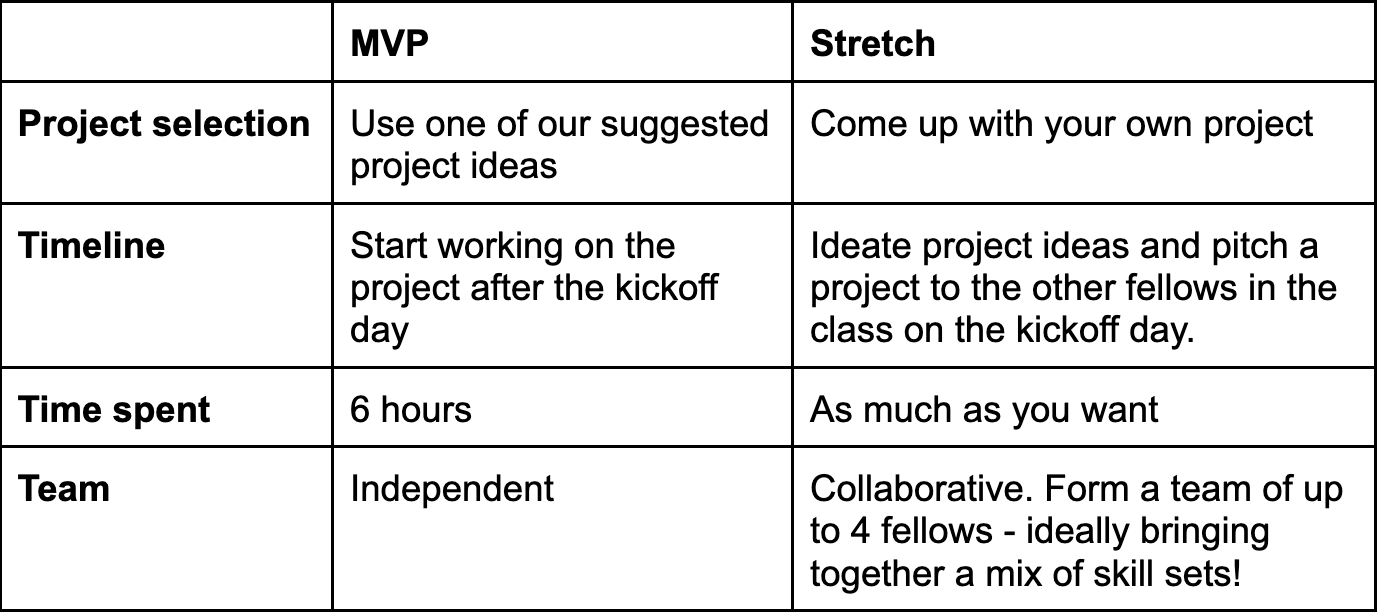Course Review of Software Stacks in Climate Tech by Terra.do


Another year, another Terra.do course completed. Having enjoyed Terra.do’s 12-week flagship course, “Climate Change: Learning for Action”, I decided to enroll in their 4-week baby course, “Software Stacks in Climate Change”. Though it’s but a wee little course, it delivered a strong punch. At a price of $500 (even less if you use a referral code or can get it partially reimbursed by your employer), I found the course to be well worth the time and money. Read on for my full review!
P.S. If you decide to enroll in LFA, you can get a 20% discount by using this referral link.
Why I enrolled
It’s not hard to believe that many of the skills tech workers employ can transfer in some very direct ways to roles in the climate space. My role as a Developer Relations Engineer may not have a direct equivalent in the climate tech space (yet 👀), but certainly there’s room for software engineers, product managers, content creators, user researchers, technical writers… all of the roles that more or less combine into my work as a DRE. The purpose behind my enrolling in this course wasn’t to show myself that there’s space for technical skills in the climate sphere, though you’d certainly learn that if you don’t believe it already. Rather, I was looking for first-hand practice with and deeper exposure to some of the ways in which software is a driving force in climate solutions.
I wanted to learn about and dig into data sets and libraries that are actually used in building real world climate-focused applications. And through that practice, I hoped to build competence, confidence, and perhaps motivation, to advance my own capacity to engage in the climate tech space. Put more simply, I enrolled to lower the barriers between myself and actually building climate solutions. This goal is admittedly rather open-ended, which I think had some bearing on my personal outcomes from the course – I’ll get to that later. Nevertheless, the course absolutely met my goals.
Your reasons for considering the course might be different from mine, but I hope you can leverage my experience to decide whether the course may be fruitful for you, and how you might make the most of it if you too decide to enroll.
Course Format & Content
You can find the latest schedule on the course website.
4 weeks of content were spread across 5 weeks:
- Week 1: Intros
- Week 2: Software x Climate Landscape | Public Data Sources
- Week 3: Energy Modeling | Software/Hardware Interfaces
- Week 4: Break / extra time to work on final projects
- Week 5: Peer reviews | Presentations
The content was delivered in 2 main formats: live Zoom sessions, which mixed lecture and discussion, and virtual “classes” in the Terra.do learning portal, which mainly consisted of curated links to articles related to the week’s topics. The class also had a Slack channel for announcements, info sharing amongst classmates, questions to instructors, final project ideation, and all that jazz.
The live Zoom sessions happened 1-2 times per week and lasted an hour, with an additional, optional half hour for Q+A. I would’ve loved to not use Zoom, particularly because the chat feature is limited and just buggy enough to be an annoyance, but all in all it worked well for the purposes of the course.
I might’ve preferred more lecture and less discussion given how short the course is (and based on an in-class poll, I wasn’t alone), but the instructors struck a near-perfect balance. The deep-dive sessions of weeks 2 and 3 delivered some really fascinating content, ranging from technical breakdowns to case studies from the industry. There was minimal content around the science of climate change, but the initial deep-dive – Software x Climate Landscape – laid the foundation for deeper discussions around software’s critical role in climate solutions across industries. For each deep dive, the virtual classes and assignments offered further reinforcement.
When it came to the virtual “classes”, I was skeptical at first to see that these were really just lists of readings. Frankly, it felt lazy next to the dozens of slides of content I’d come to expect from Terra based on my experience with ‘Learning for Action’. That said, my skepticism dwindled quickly when I realized (1) the fact of there being minimal slides and only 1-3 readings per class made it easier for me to maintain focus and retain the information, unlike the occasional information overload I felt in LFA; and (2) the readings were actually really well selected and engaging.
Assignments
While the live Zoom sessions and virtual classes laid the foundation and scaffolding, I found that the assignments were where the course really took shape. There were 4 assignments overall, which spanned the first 3 weeks, culminating in a final project. All of the assignments were completed in Hex notebooks, which was a new tool for me but easy enough to navigate and quite similar to Jupyter notebooks.
In every assignment, the instructors had put together some starter code to build upon, with plenty of comments explaining the overall intent of the notebook and what each piece of code did within it. In between blocks of code were interactive data visualizations that invited us to explore and reconfigure the data to see what sense we could make of it. This design made it possible for non-software engineers (almost 50% of the students, if I remember correctly!) to complete the assignments without having to know much about coding. For those with more coding experience, the instructors offered suggestions for further investigation, making the assignments very choose-your-own-adventure. Assignments weren’t graded, but you do need to turn in your completed Hex notebook with some remarks about what insights you derived in order to receive a course completion certificate (like this one! Isn’t it pretty?). Plus, the instructors read through every assignment and leave comments ranging from recommended enhancements or questions to some variation of “Great work!”.
One example – without going into too much detail – was the “Home energy model” assignment. In this Hex notebook, the instructors created a “toy model” to simulate a home’s energy usage based on some basic inputs like location and window direction. It combined those inputs with a public dataset – historical weather data provided by NREL (National Renewable Energy Laboratory) and fetched through pvlib – to produce a timeseries of energy usage which could in theory be used for things like minimizing home energy usage through smart device optimization. The assignment made a bunch of simplifications, but even so it was a powerful example of a piece of software that could actually get us (humanity) closer to un-screwing ourselves.
At the same time as each assignment took a piece of the climate tech landscape and made it more concrete and accessible, it also imbued for me a sense of possibility around climate efforts more broadly. To me, this was one of the course’s greatest accomplishments.
I should also note that the software/hardware deep-dive assignment provided the option of ordering your own IoT kit to set up a sensor which would collect CO2 readings to be leveraged by the Hex code. I and several others opted out of this piece, but many students who partook lauded the challenge of it.
Final Project
The assignments culminated in the final project, which spanned the last 2 weeks of the course and which was even more of an open-ended adventure than the rest of the coursework. While this certainly added to the challenge and the mental bandwidth required to actually produce something meaningful, on the whole I found the open-ended approach to be really exciting and inspiring. On the one hand, I was stressed about the decision paralysis that came with the freedom to pick any direction for the project. On the other hand, going through the exercise of brainstorming potential problem areas and uncovering ideas waiting to be explored was genuinely fun and left me feeling optimistic.
To the instructors’ credit, they did provide some suggested project ideas and granted access to the backlog of past students’ projects, so you have the option of picking from a selection of ideas. The open-ended, at times paralyzingly broad approach was largely self-inflicted to be sure. In fact, the “come up with your own project” path was deemed a “stretch” according to the provided guidelines:

The other “stretch” I undertook was to join a team rather than work independently, which turned out to be the more common choice with about 10 people working individually and about 20 on teams of 2-5. I think either approach would’ve been ok; I’d originally planned to fly solo, largely so that I could avoid imposing my busy schedule onto a team, but I was lured into a group by a persuasive PM with an idea that was loosely related to mine (thanks Zach :D).
At the end of the day, I contributed a lot more technical research than actual working code, which I feel just okay about. This was a byproduct of the level of complexity of what I was trying to solve for, the limitations of the existing landscape and tooling, and the [insufficient] amount of time I had set aside for the project. Still, the thought experimentation and the deep dive into a part of the climate tech landscape I hadn’t touched before was totally worthwhile, as were the exploratory conversations I had with my team. I only wish I had more to show for my contribution than a write-up of my findings and some demo code built on sample data whose format (HPXML, i.e. “Home Properties XML”) was too bespoke to be incorporated into our project in time. I think this outcome was less a reflection of how the course and the final project were designed than it was a reflection of my own expectations around and approach to such a complex topic; in that sense, it was a learning experience beyond the climate tech aspect.
Ultimately, everyone presented their final projects, and it was impressive and motivating to see the level of accomplishment across such a wide spectrum of skill sets and interests. Projects ranged from comical storytelling about the climate impact of money trees, to backend systems for grid energy management, to data analysis of grocery item carbon impact. Many students crushed the course’s advertised goal of walking away with a “resumé-worthy” project. While I don’t count myself among those students, I believe I could’ve achieved that outcome if I’d made it an explicit goal for myself. Now with the course behind me, I feel confident that I could develop a resumé-worthy climate tech project on my own using the skills and knowledge I acquired through the course.
Instructors
The course was taught by couple Jaime and Jason, two former Big Tech employees who pivoted to working at climate tech startups before ultimately founding their own climate tech consulting company called Option Zero. Jaime and Jason know their stuff, and thank goodness they’re not gatekeeping it. With such relevant real-world experience, they were able to incorporate in-depth case studies and grounded knowledge into the course instruction, which made the content more compelling while also making the whole of climate tech feel more within reach – after all, these people succeeding in climate tech are right here talking to you.
Jaime and Jason clearly care about empowering students to find their paths in climate tech, and it showed in the quality of the content, their commitment to being available to students, and in their level of engagement with the assignments and final projects. They were fantastic resources for the array of questions that came up related to assignments, final projects, or whatever curiosities arose along the way. Considering their dedication, in combination with the fact that they solicited feedback from students regularly, I see the course only getting better and better with each run.
Classmates
The diversity and commitment of the student body was one of the most appealing and inspiring aspects of the course. Even though a majority of students worked in tech in some facet, the industries, roles, and experience levels varied widely.
It was genuinely wholesome to see firsthand that so many talented and kind people are interested in tackling climate change through software. Just like in LFA, the course created a community that fostered support and curiosity; it was a safe space to ask possibly naive questions, to propose ideas, and to make connections. I even met up with another classmate local to NYC (and there would've been more classmates too if it weren’t for you meddling sickness! *shakes fist at flu*). By the end of the class, having watched the final project presentations, I felt in awe of my classmates and the change that’s possible through a group of merely ~30 students.
Final Thoughts
With the course now a month behind me, I’m glad I made the decision to enroll. I feel I’ve opened the door to climate that much wider. I only wish I’d set aside more time for the assignments and final project so that I could’ve invested more fully for a greater return.
Now the question is whether I’ll actually carry forward what I’ve learned from the course and apply it directly – in personal projects, a 20% project at work, or a career move. I can’t answer that for sure yet. But I can say the question has become less one of “whether” I will get more hands on with climate and more so “when and how”.
Even as I question whether my path in climate will leverage the knowledge I’ve picked up in this course, I see that taking the course has reaffirmed my investment in working on climate in general. I’ve enrolled in the NYC Trash Academy, and I’ve continued to be involved in climate communities like Greenglers at Google and, of course, the Terra.do community. I’m more optimistic about climate than I was when I started, and my thinking about climate problems now has an additional constructive lens through which to understand the issues and ideate paths to solving them.
Maybe the best gift this course gave me was the sweet taste of building climate solutions. Now, I’m hungry for more.
Free Money
In case you missed it, note that you can get a 20% discount by using this referral link.

